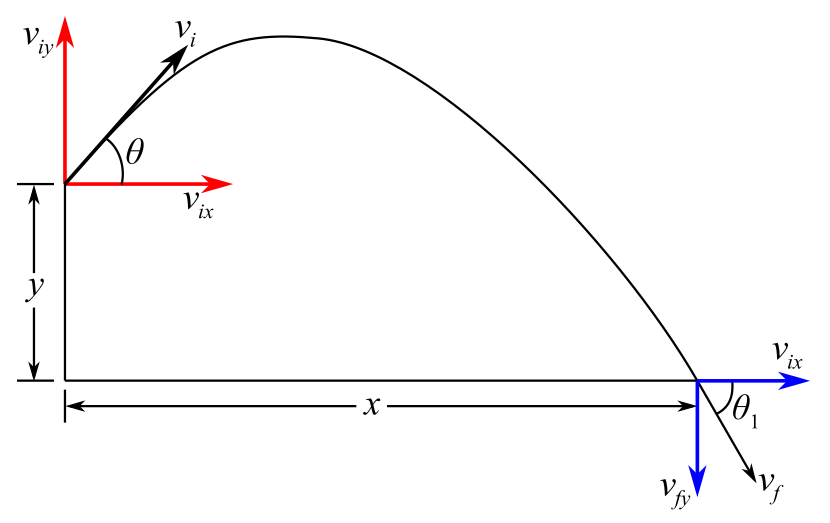
Concept explainers
A body is projected downward at an angle of
striking the ground? (b) How far from the foot of the building will it strike? (c) At what angle with the horizontal will it strike?
(a)
The time taken by the body to hit the ground if it is projected downward at an angle of
Answer to Problem 45SP
Solution:
Explanation of Solution
Given data:
The downward angle made by the body with the horizontal is
The initial speed of body is
The height of the building from the ground is
Formula used:
The expression for the vertical component of the initial velocity is written as,
Here,
The expression for the vertical displacement of the object in horizontal motion is written as,
Here,
Explanation:
Draw the diagram according to the problem.

Here,
Recall the expression for the vertical component of the initial velocity.
Substitute
Recall the expression for the vertical displacement of the object.
Substitute
Solve the quadratic equation for
Or,
Understand that, the time cannot be negative. So, the time of flight will be
Conclusion:
Hence, the time taken by the body to hit the ground is
(b)
The horizontal distance traveled by the body from the foot of the building to striking point, if it is projected downward from the building of height
Answer to Problem 45SP
Solution:
Explanation of Solution
Given data:
The downward angle made by the body with the horizontal is
The initial speed of body is
The height of the building from the ground is
Formula used:
The expression for the horizontal component of the initial velocity is written as,
Here,
The expression for the horizontal displacement of the body which follows projectile motion is written as,
Here,
Explanation:
Recall the expression for the horizontal component of the initial velocity.
Substitute
Recall the expression for the horizontal displacement of the body which follows projectile motion.
Substitute
Conclusion:
Hence, the distance traveled by the body from the foot of the building to striking point is
(c)
The angle made by the body with horizontal when it will strike the groundif it is projected downward at an angle of
Answer to Problem 45SP
Solution:
Explanation of Solution
Given data:
The downward angle made by the body with the horizontal is
The initial speed of body is
The height of the building from the ground is
Formula used:
The expression for the horizontal component of the initial velocity is written as,
Here,
The expression for the vertical component of the initial velocity is written as,
The expression for the
Here,
The expression for the
Here,
Explanation:
Redraw the diagram according to problem.

Recall the expression for the horizontal component of the initial velocity.
Substitute
Recall the expression for the vertical component of the initial velocity.
Substitute
Recall the expression for the
Substitute
Write the expression for the angle made by the body with the horizontal when it strikes the ground.
Or,
Substitute
Understand that, the velocity along the horizontal remains constant throughout the given projectile motion but the vertical component of the velocity changes.
Conclusion:
Hence, the angle made by the body with horizontal when it will strike is
Want to see more full solutions like this?
Chapter 2 Solutions
Schaum's Outline of College Physics, Twelfth Edition (Schaum's Outlines)
- If the block does reach point B, how far up the curved portion of the track does it reach, and if it does not, how far short of point B does the block come to a stop? (Enter your answer in m.)arrow_forwardTruck suspensions often have "helper springs" that engage at high loads. One such arrangement is a leaf spring with a helper coil spring mounted on the axle, as shown in the figure below. When the main leaf spring is compressed by distance yo, the helper spring engages and then helps to support any additional load. Suppose the leaf spring constant is 5.05 × 105 N/m, the helper spring constant is 3.50 × 105 N/m, and y = 0.500 m. Truck body yo Main leaf spring -"Helper" spring Axle (a) What is the compression of the leaf spring for a load of 6.00 × 105 N? Your response differs from the correct answer by more than 10%. Double check your calculations. m (b) How much work is done in compressing the springs? ☑ Your response differs significantly from the correct answer. Rework your solution from the beginning and check each step carefully. Jarrow_forwardA spring is attached to an inclined plane as shown in the figure. A block of mass m = 2.71 kg is placed on the incline at a distance d = 0.285 m along the incline from the end of the spring. The block is given a quick shove and moves down the incline with an initial speed v = 0.750 m/s. The incline angle is = 20.0°, the spring constant is k = 505 N/m, and we can assume the surface is frictionless. By what distance (in m) is the spring compressed when the block momentarily comes to rest? m m 0 k wwwwarrow_forward
- A block of mass m = 2.50 kg situated on an incline at an angle of k=100 N/m www 50.0° is connected to a spring of negligible mass having a spring constant of 100 N/m (Fig. P8.54). The pulley and incline are frictionless. The block is released from rest with the spring initially unstretched. Ө m i (a) How far does it move down the frictionless incline before coming to rest? m (b) What is its acceleration at its lowest point? Magnitude m/s² Direction O up the incline down the inclinearrow_forward(a) A 15.0 kg block is released from rest at point A in the figure below. The track is frictionless except for the portion between points B and C, which has a length of 6.00 m. The block travels down the track, hits a spring of force constant 2,100 N/m, and compresses the spring 0.250 m from its equilibrium position before coming to rest momentarily. Determine the coefficient of kinetic friction between the block and the rough surface between points B and C. -A 3.00 m B C -6.00 m i (b) What If? The spring now expands, forcing the block back to the left. Does the block reach point B? Yes No If the block does reach point B, how far up the curved portion of the track does it reach, and if it does not, how far short of point B does the block come to a stop? (Enter your answer in m.) marrow_forwardA ball of mass m = 1.95 kg is released from rest at a height h = 57.0 cm above a light vertical spring of force constant k as in Figure [a] shown below. The ball strikes the top of the spring and compresses it a distance d = 7.80 cm as in Figure [b] shown below. Neglecting any energy losses during the collision, find the following. т m a d T m b i (a) Find the speed of the ball just as it touches the spring. 3.34 m/s (b) Find the force constant of the spring. Your response differs from the correct answer by more than 10%. Double check your calculations. kN/marrow_forward
- I need help with questions 1-10 on my solubility curve practice sheet. I tried to my best ability on the answers, however, i believe they are wrong and I would like to know which ones a wrong and just need help figuring it out.arrow_forwardQuestion: For a liquid with typical values a = 10-3K-¹ K = 10-4 bar-1 V=50 cm³ mol-1, Cp 200 J mol-1K-1, calculate the following quantities at 300 K and 1 bar for one mole of gas: 1. () P ән 2. (9) T 3. (V) T 4. (1) P 5. (9) T 6. Cv 7. (OF)Tarrow_forwardA,B,C AND Darrow_forward
- A bungee jumper plans to bungee jump from a bridge 64.0 m above the ground. He plans to use a uniform elastic cord, tied to a harness around his body, to stop his fall at a point 6.00 m above the water. Model his body as a particle and the cord as having negligible mass and obeying Hooke's law. In a preliminary test he finds that when hanging at rest from a 5.00 m length of the cord, his body weight stretches it by 1.55 m. He will drop from rest at the point where the top end of a longer section of the cord is attached to the bridge. (a) What length of cord should he use? Use subscripts 1 and 2 respectively to represent the 5.00 m test length and the actual jump length. Use Hooke's law F = KAL and the fact that the change in length AL for a given force is proportional the length L (AL = CL), to determine the force constant for the test case and for the jump case. Use conservation of mechanical energy to determine the length of the rope. m (b) What maximum acceleration will he…arrow_forward210. Sometimes the Helmholtz free energy F(T, V, N) divided by temperature, T, is an interesting quantity. For example, the quantity is proportional to the logarithm of the equilibrium constant or solubilities. A. Derive a relationship showing that Find the constant of proportionality. a F αυ ƏT T B. Suppose F(T) depends on temperature in the following way: F(T)=2aT²+bT. Find S(T) and U(T).arrow_forwardchoosing East (e) is not correct!arrow_forward
 Principles of Physics: A Calculus-Based TextPhysicsISBN:9781133104261Author:Raymond A. Serway, John W. JewettPublisher:Cengage Learning
Principles of Physics: A Calculus-Based TextPhysicsISBN:9781133104261Author:Raymond A. Serway, John W. JewettPublisher:Cengage Learning University Physics Volume 1PhysicsISBN:9781938168277Author:William Moebs, Samuel J. Ling, Jeff SannyPublisher:OpenStax - Rice University
University Physics Volume 1PhysicsISBN:9781938168277Author:William Moebs, Samuel J. Ling, Jeff SannyPublisher:OpenStax - Rice University College PhysicsPhysicsISBN:9781285737027Author:Raymond A. Serway, Chris VuillePublisher:Cengage Learning
College PhysicsPhysicsISBN:9781285737027Author:Raymond A. Serway, Chris VuillePublisher:Cengage Learning Classical Dynamics of Particles and SystemsPhysicsISBN:9780534408961Author:Stephen T. Thornton, Jerry B. MarionPublisher:Cengage Learning
Classical Dynamics of Particles and SystemsPhysicsISBN:9780534408961Author:Stephen T. Thornton, Jerry B. MarionPublisher:Cengage Learning An Introduction to Physical SciencePhysicsISBN:9781305079137Author:James Shipman, Jerry D. Wilson, Charles A. Higgins, Omar TorresPublisher:Cengage Learning
An Introduction to Physical SciencePhysicsISBN:9781305079137Author:James Shipman, Jerry D. Wilson, Charles A. Higgins, Omar TorresPublisher:Cengage Learning Glencoe Physics: Principles and Problems, Student...PhysicsISBN:9780078807213Author:Paul W. ZitzewitzPublisher:Glencoe/McGraw-Hill
Glencoe Physics: Principles and Problems, Student...PhysicsISBN:9780078807213Author:Paul W. ZitzewitzPublisher:Glencoe/McGraw-Hill





